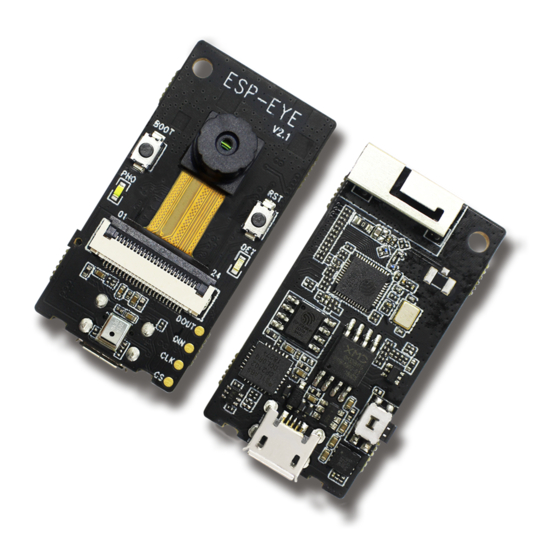
Summary of Contents for Espressif Systems ESP-EYE
- Page 1 ESP-EYE User manual Version 0.1 Espressif Systems Copyright © 2019 www.espressif.com...
-
Page 2: About This Guide
About This Guide This document describes the specification of the ESP-EYE development board. Release Notes Date Version Release notes 2019.01 V0.1 For certification purpose. Documentation Change Notification Espressif provides email notifications to keep customers updated on changes to technical documentation. Please subscribe at https://www.espressif.com/en/subscribe. - Page 3 Overview ESP-EYE is an ESP32-based development board that integrates a digital microphone, 8 MB PSRAM and 4 MB flash, as well as provides an external 2-million-pixel camera, which makes the board very suitable for applications in the fields of face detection, face recognition, and speech recognition.
-
Page 4: Circuit Components
Circuit Components Figure 3-1. ESP-EYE Circuit components The list and figure below describe the key components, interfaces, and controls of the ESP- EYE development board: 3D_PIFA Antenna A 3D PIFA antenna is used for this module, The antenna gain is 2.98dBi. -
Page 5: Led Indicators
Flash & PSRAM Provides memory to store applications. CP2102 USB-to-UART Chip Converts the USB signals to UART signals. USB Port Provides the power supply to the whole system. LDO Power Supply Provides the required power supplies to the ESP32 chip, camera and LED indicators. Side Tactile Button A function key Top Tactile Button... -
Page 6: Limit Parameters
3.1. Limit Parameters Table 1. ESP-EYE Limit Parameters Parameter Symbol Unit Power supply 4.75 5.25 voltage Power supply current Low-level input -0.3 0.25xV voltage High-level input 0.75xV +0.3 voltage Input leak current I Pin capacitance Low-level output 0.1xV voltage High-level output 0.8xV... - Page 7 HT20, MCS0 HT20, MCS7 HT40, MCS0 HT40, MCS7 Adjacent channel rejection OFDM, 6 Mbps OFDM, 54 Mbps HT20, MCS0 HT20, MCS7 Table 3. ESP-EYE BT Performance Description Unit 2480 Frequency range 2402 TX power BLE:2.17dBm,BT:5.82dBm RF output power Receiver Characteristics...
- Page 8 Transmitter Characteristics Parameter Conditions Unit F = F0 ± 2 MHz –52 Adjacent channel transmit power F = F0 ± 3 MHz – F = F0 ± > 3 MHz – ∆ f1 avg ∆ f2 max ∆ f2 avg /∆ f1 avg –...
- Page 9 Dimensions Espressif 2019.01...
- Page 10 FCC Statement Any Changes or modifications not expressly approved by the party responsible for compliance could void the user’s authority to operate the equipment. This device complies with part 15 of the FCC Rules. Operation is subject to the following two conditions: (1) This device may not cause harmful interference, and (2) This device must accept any interference received, including interference that may cause undesired operation.



Need help?
Do you have a question about the ESP-EYE and is the answer not in the manual?
Questions and answers